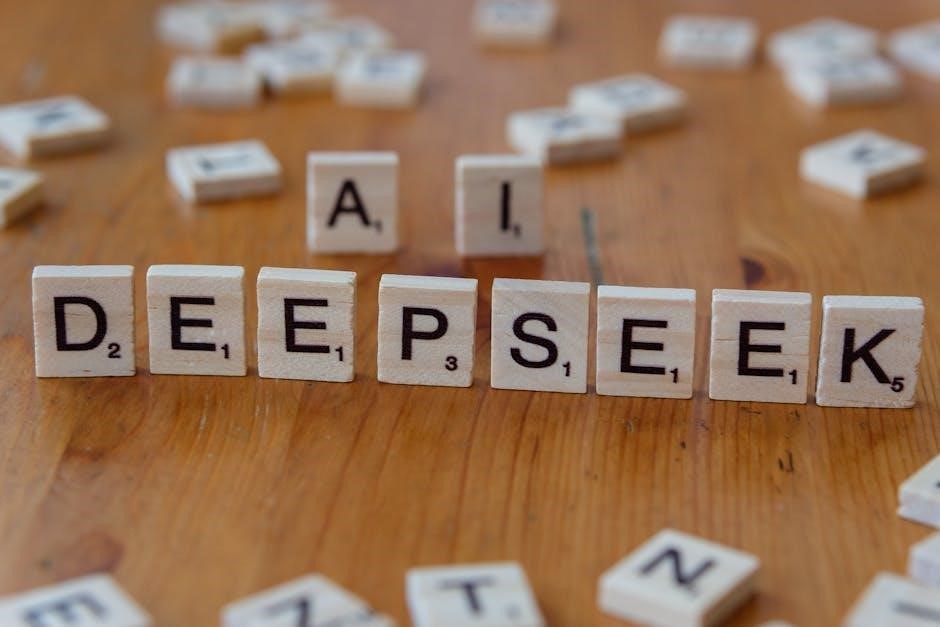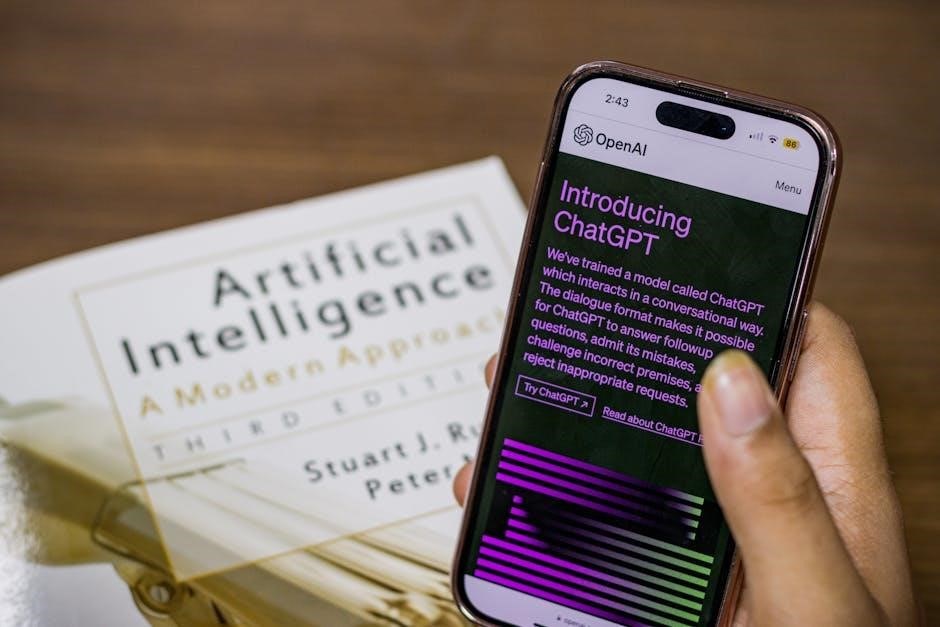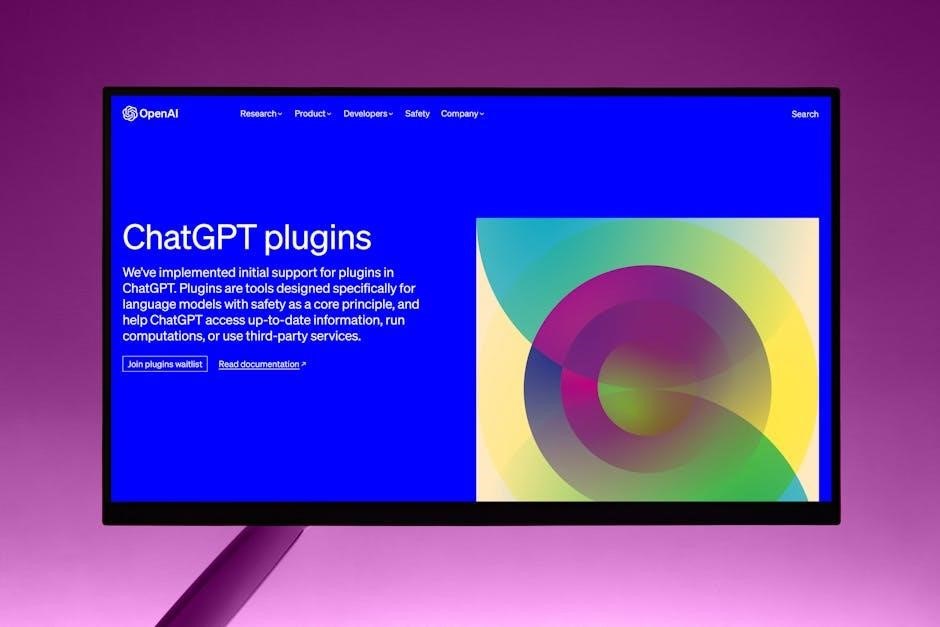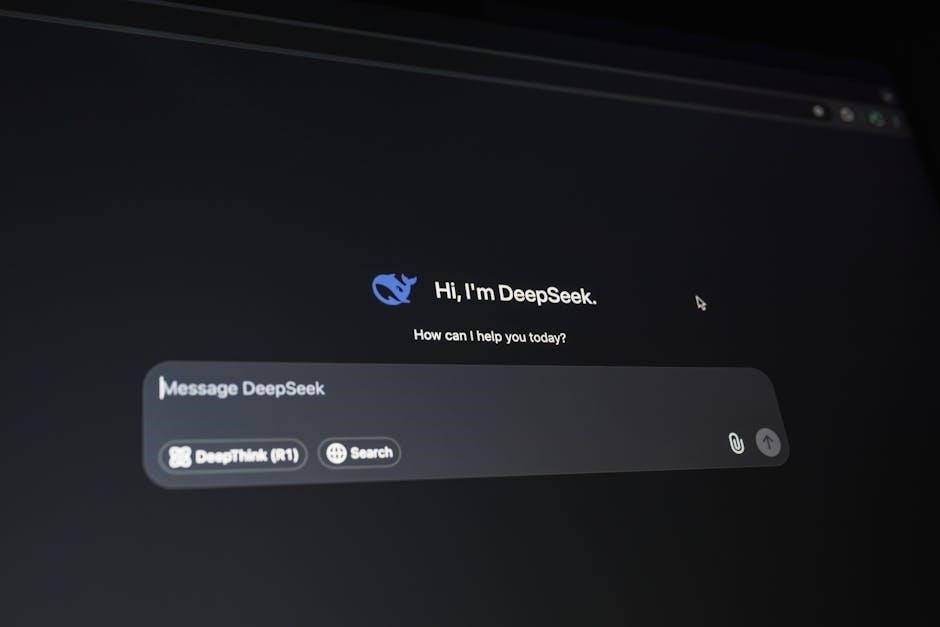ChatGPT’s integration with PDF files enables efficient extraction, analysis, and interaction with document content, enhancing productivity and decision-making across various professional and academic domains.
1.1 Overview of ChatGPT and Its Capabilities
ChatGPT, developed by OpenAI, is a cutting-edge AI model designed for natural-sounding conversations. It excels in understanding and generating human-like text, enabling it to assist with diverse tasks. The model processes and analyzes PDF files, extracting text, summarizing content, and retrieving specific information. Its ability to integrate with PDFs enhances productivity in academic, professional, and creative contexts. This integration allows users to leverage ChatGPT for tasks like document analysis, research, and content creation, making it a versatile tool for modern workflows.
1.2 Understanding PDF Filetype and Its Relevance
The Portable Document Format (PDF) is a widely-used file type designed to maintain document integrity across devices. It supports text, images, and tables, making it ideal for professional and academic use. PDFs are valued for their fixed layout, which preserves formatting, and their ability to embed fonts and multimedia. Their versatility in capturing complex structures and ensuring consistent presentation has made them a standard for sharing and archiving content. This reliability underscores their importance in integrating with tools like ChatGPT for enhanced document processing and analysis.
1.3 Importance of Integrating ChatGPT with PDF Files
Integrating ChatGPT with PDF files bridges the gap between advanced AI capabilities and structured document content. This synergy enables efficient extraction of insights, automates tasks like summarization, and enhances accessibility of information. By leveraging ChatGPT’s analytical prowess, users can unlock hidden data within PDFs, facilitating better decision-making and productivity. This integration is particularly valuable in academic research, business analytics, and content creation, where quick access to relevant information is crucial. It revolutionizes how we interact with and derive value from PDF documents, making it an essential tool for modern workflows.

Key Features of ChatGPT in Handling PDF Files
ChatGPT excels in extracting text, summarizing content, and retrieving specific information from PDFs, enhancing efficiency and productivity for users handling complex documents.
2.1 Text Extraction and Analysis from PDFs
ChatGPT efficiently extracts text from PDFs, enabling users to analyze and process document content effectively. This feature supports keyword searches, entity recognition, and contextual understanding, making it invaluable for research and professional tasks. By leveraging advanced NLP, ChatGPT can identify key themes and insights, transforming static PDF content into actionable data. This capability streamlines workflows, enhances decision-making, and provides users with a powerful tool for managing and interpreting complex documents.
2.2 Summarization of PDF Content
ChatGPT excels at summarizing PDF content, providing concise and accurate overviews of complex documents. Users can request summaries of varying lengths, ensuring key points are highlighted while preserving context. This feature is particularly useful for academic papers, reports, and lengthy articles, saving time and enhancing understanding. By leveraging advanced NLP, ChatGPT identifies central themes and delivers summaries that capture the essence of the content, making it an invaluable tool for researchers, professionals, and students seeking to quickly grasp document essentials.
2.3 Information Retrieval from PDFs
ChatGPT enables users to retrieve specific information from PDF documents efficiently. By uploading or pasting text, users can ask targeted questions, and ChatGPT will extract relevant details. This feature is particularly useful for locating key data, such as names, dates, or specific concepts, within lengthy documents. Advanced search capabilities allow users to pinpoint information quickly, saving time and effort. ChatGPT’s ability to understand context ensures accurate and relevant results, making it a powerful tool for researchers, professionals, and anyone needing to extract specific information from PDF files.

How ChatGPT Processes PDF Files
ChatGPT processes PDF files by parsing their structure, extracting text, and analyzing content. It handles layouts, images, and tables, preparing data for further analysis or generation.

3.1 Parsing PDF Structure and Layout
ChatGPT parses PDF structure by identifying text, images, tables, and layouts. It navigates through document hierarchy, detecting formatting elements like fonts, margins, and sections. For scanned PDFs, OCR technology is often employed to recognize text. Complex layouts, such as multi-column pages, are analyzed to maintain content organization. This parsing enables accurate information extraction, facilitating tasks like summarization and analysis. Effective parsing is crucial for ensuring that ChatGPT can interpret and process PDF content reliably, making it accessible for various applications.
3.2 Handling Text, Images, and Tables in PDFs
ChatGPT effectively processes text, images, and tables within PDFs. Text is extracted for analysis, while images are identified and described. Tables are parsed to maintain data structure, enabling precise information retrieval. Advanced OCR technology aids in deciphering scanned or image-based content. However, complex layouts or mixed media may pose challenges, requiring additional processing. ChatGPT’s ability to handle diverse content types ensures comprehensive understanding and utilization of PDF documents for various applications, enhancing productivity and efficiency in data-driven tasks.

3.3 Dealing with Encoded or Scanned PDFs
ChatGPT utilizes OCR (Optical Character Recognition) to process encoded or scanned PDFs, enabling text extraction from images. While it effectively handles standard scans, encoded text or low-quality scans may require additional tools for accurate interpretation. Images and tables are described, but complex layouts or color/grayscale variations can hinder processing. ChatGPT’s ability to manage scanned PDFs enhances accessibility, though limitations remain for highly encoded or distorted files, necessitating manual correction or advanced preprocessing for optimal results in such cases.

Generating PDF Files Using ChatGPT
ChatGPT can generate PDFs from text-based inputs, enabling users to create structured documents. It integrates with tools for custom formatting, offering tailored solutions for specific needs and preferences.
4.1 Creating PDFs from Text-Based Inputs
ChatGPT enables users to generate PDFs directly from text-based inputs, offering a seamless way to convert structured or unstructured text into formatted documents. This feature is particularly useful for creating reports, articles, or eBooks. By leveraging natural language processing, ChatGPT can interpret and organize text into a coherent PDF layout. For instance, users can input detailed research findings or instructional content, and ChatGPT can structure it into sections, complete with headings and bullet points. Additionally, customization options allow users to specify fonts, margins, and other formatting preferences, ensuring the final PDF meets their specific needs. This capability streamlines content creation, making it efficient and accessible for professionals and creators alike.
4.2 Customizing PDF Output for Specific Needs
ChatGPT allows users to tailor PDF outputs to meet specific requirements, ensuring the final document aligns with their goals. By specifying formatting preferences such as fonts, page layouts, and margins, users can create professional-grade PDFs. Additionally, ChatGPT can incorporate custom templates, enabling consistent branding or styling. For example, businesses can generatePDF reports with company logos and color schemes, while educators can design educational materials with engaging layouts. This customization feature enhances the versatility of PDF generation, making it suitable for diverse applications and audiences. It simplifies the process of creating visually appealing and functional documents.
4.3 Integrating ChatGPT with PDF Generation Tools
Integrating ChatGPT with PDF generation tools enhances the creation of dynamic, AI-driven documents. By leveraging ChatGPT’s text generation capabilities alongside tools like Adobe Acrobat or Smallpdf, users can automate PDF creation from prompts or templates. This integration streamlines workflows, enabling consistent and efficient document production. For instance, businesses can generate contracts or reports with predefined structures, while educators can create customized learning materials. The seamless interaction between ChatGPT and PDF tools ensures high-quality, tailored outputs, catering to specific needs across industries.

Limitations of ChatGPT in PDF Processing
ChatGPT’s PDF processing is limited by its reliance on external tools, struggles with complex layouts, and inability to accurately interpret scanned or image-based PDFs effectively.
5.1 Dependence on External Tools for PDF Handling
ChatGPT relies on external tools for PDF processing, as it lacks native PDF handling capabilities. This dependence can lead to compatibility issues and additional steps for users. While ChatGPT excels in text-based interactions, processing PDFs often requires third-party software like Adobe Acrobat or online converters to extract text. This limitation can hinder seamless integration, especially for users seeking direct PDF analysis without extra tools. Despite its advanced capabilities, ChatGPT’s reliance on external solutions remains a significant drawback in handling PDF files effectively.
5.2 Challenges with Complex PDF Structures
ChatGPT faces challenges when dealing with PDFs containing complex layouts, such as tables, images, and multi-column text. These structures can confuse the model, leading to inaccurate text extraction or misinterpretation of content. Additionally, PDFs with encoded fonts or non-standard formatting may result in incomplete or garbled text when processed. While ChatGPT excels at analyzing plain text, its inability to natively handle complex PDF structures limits its effectiveness for documents requiring precise layout interpretation. This limitation underscores the need for additional tools to preprocess PDFs before analysis, ensuring accurate results for users working with intricate documents.
5.3 Limitations in Handling Large PDF Files
ChatGPT faces challenges when processing large PDF files due to memory and computational constraints. Extensive documents with numerous pages or complex content often lead to slower processing times and potential information loss. Additionally, the model’s inability to natively handle large files without external tools limits its efficiency. While ChatGPT excels at analyzing smaller, concise PDFs, its performance diminishes with larger files, affecting accuracy and reliability. This limitation highlights the need for complementary tools to preprocess and optimize PDFs before analysis, ensuring effective handling of extensive documents.

Applications of ChatGPT-PDF Integration
ChatGPT-PDF integration streamlines tasks like academic research, business reporting, and educational content creation, enabling efficient extraction, analysis, and generation of insights from PDF documents.
6.1 Academic and Research Applications
ChatGPT-PDF integration revolutionizes academic and research workflows by enabling seamless extraction and analysis of information from PDF documents. Researchers can quickly summarize lengthy papers, extract key findings, and organize references efficiently. This tool also aids in generating citations, drafting literature reviews, and identifying research gaps. For educators, it simplifies creating course materials and grading by analyzing PDF submissions. Additionally, it facilitates collaboration by converting complex PDF data into accessible formats for teams. This integration is particularly valuable for disciplines like finance, where analyzing PDF-based financial reports and curricula, such as the Cha-Ching program, becomes more efficient. It also supports understanding API explanations in technical documents, aiding developers and researchers alike. By streamlining these processes, ChatGPT-PDF integration enhances productivity and accuracy in academic and research environments.
6.2 Business and Professional Use Cases
ChatGPT-PDF integration offers versatile solutions for businesses, enabling efficient processing of financial reports, contracts, and technical documents. Professionals can automate tasks like data extraction, report summarization, and document analysis, saving time and reducing errors. This integration is particularly useful for industries like finance, where parsing PDF-based reports and curricula, such as the Cha-Ching program, streamlines decision-making. It also supports municipal planning by analyzing urban infrastructure documents and aiding in strategy development. Additionally, it facilitates travel companies by providing quick access to information, enhancing customer service and operational planning. By integrating with business tools, ChatGPT-PDF enhances workflow efficiency and supports informed decision-making across sectors.
6.3 Educational and Training Purposes
ChatGPT-PDF integration is a powerful tool in education, enabling educators and students to extract insights from academic papers, textbooks, and research documents. It simplifies the analysis of complex PDF materials, such as financial literacy curricula like Cha-Ching, by summarizing key concepts and providing study guides. This integration also supports creative writing programs, as seen in Ponder Review, by offering resources and prompts for students. Additionally, it aids in language learning by explaining grammatical terminology and enhancing comprehension of educational content. This makes learning more accessible and engaging for students of all levels.

Best Practices for Using ChatGPT with PDFs
Ensure high-quality PDF input, optimize prompts for specific tasks, and verify outputs for accuracy, leveraging ChatGPT’s capabilities to enhance educational and professional efficiency effectively.
7.1 Ensuring High-Quality PDF Input
High-quality PDF input is crucial for effective processing by ChatGPT. Ensure text is clear, well-formatted, and free from scanned or image-based content. Use OCR tools to convert scanned PDFs to editable text. Avoid PDFs with complex layouts or embedded images, as they may hinder accurate extraction. Verify that fonts are legible and that tables or special formatting are preserved. Consistency in formatting enhances ChatGPT’s ability to analyze and summarize content efficiently. Always preview PDFs before processing to identify potential issues that could impact results.
7.2 Optimizing ChatGPT Prompts for PDF Tasks
Optimizing ChatGPT prompts for PDF tasks involves clear, specific instructions. Specify the desired output, such as summarization or extraction, and provide context for better understanding. Use precise language to guide ChatGPT effectively, ensuring accurate results. For complex PDFs, break tasks into smaller, manageable steps. Regularly refine prompts based on feedback to enhance accuracy. Leveraging these strategies ensures efficient and reliable processing of PDF content, maximizing ChatGPT’s capabilities in handling various document-related tasks.
7.3 Verifying Output Accuracy and Relevance
Verifying ChatGPT’s output accuracy and relevance is crucial for reliable results. Cross-reference extracted or generated content with the original PDF to ensure consistency; Check for contextual understanding, especially in complex or technical documents. Use specific examples, like financial data or API explanations, to validate accuracy. Ensure summaries align with the source material, such as Dr. Willett’s nutritional advice. For sensitive tasks, human oversight is essential to confirm outputs meet requirements and maintain intended meaning, particularly in fields like municipalist strategies or skin sensitization studies.

Future Prospects of ChatGPT-PDF Integration
Advancements in AI will enhance ChatGPT’s PDF processing, enabling seamless integration for education, business, and research. Improved accessibility and efficiency will drive innovation across industries, fostering growth and collaboration.
8.1 Advancements in PDF Processing Capabilities
Future advancements in ChatGPT’s PDF processing will focus on improving text extraction accuracy, handling complex layouts, and enhancing image and table recognition. AI-driven improvements will enable better parsing of encoded or scanned PDFs, ensuring clearer and more precise data retrieval. Additionally, advancements in natural language processing will allow ChatGPT to better understand and interpret PDF content, making it easier to summarize, analyze, and generate insights. These enhancements will make ChatGPT a more versatile tool for professionals and researchers, streamlining workflows and improving productivity across industries.
8.2 Enhanced Integration with AI Tools
Enhanced integration of ChatGPT with advanced AI tools will revolutionize PDF processing. By leveraging cutting-edge technologies like OCR and NLP, ChatGPT will seamlessly interact with PDFs, improving text extraction, image recognition, and content generation. Integration with workflow automation tools will enable users to process and analyze PDFs more efficiently. Additionally, collaboration with specialized AI services, such as layout analysis and data extraction platforms, will further enhance ChatGPT’s capabilities, making it a comprehensive solution for handling complex PDF tasks in various industries.
8.3 Potential Impact on Various Industries
ChatGPT-PDF integration holds transformative potential across industries. In academia, it can streamline research workflows and enhance paper analysis. Businesses can automate document processing, improving efficiency. Healthcare and legal sectors benefit from rapid extraction of critical data, while education leverages interactive PDF content. This integration fosters innovation, enabling industries to unlock new possibilities in data utilization, collaboration, and decision-making, driving progress and scalability across sectors.
ChatGPT’s integration with PDFs revolutionizes document interaction, offering enhanced efficiency and accessibility across industries, while paving the way for future advancements in AI-driven document processing solutions.
9.1 Recap of ChatGPT and PDF Integration
ChatGPT’s integration with PDF files has proven transformative, enabling seamless extraction, summarization, and interaction with document content. This synergy enhances productivity, offering users efficient access to information while maintaining accuracy. By leveraging AI-driven capabilities, ChatGPT simplifies complex PDF processing tasks, making it an invaluable tool for professionals, researchers, and educators. The integration not only streamlines workflows but also opens new possibilities for automating tasks, ensuring scalability and adaptability across diverse industries. This collaboration between advanced AI and traditional document formats underscores the potential for future innovations in data handling and accessibility.
9.2 Final Thoughts on the Topic
ChatGPT’s integration with PDF files represents a significant leap in leveraging AI for document processing, offering unparalleled efficiency and innovation. This synergy empowers users to extract insights, automate tasks, and enhance workflows seamlessly. As PDFs remain integral to professional and academic spheres, ChatGPT’s capabilities provide a powerful tool for modern challenges. Embracing this integration fosters productivity and opens doors to new possibilities. With continuous advancements in AI, the future of PDF processing promises even greater potential, making this integration a cornerstone of digital evolution and a testament to technological progress.
